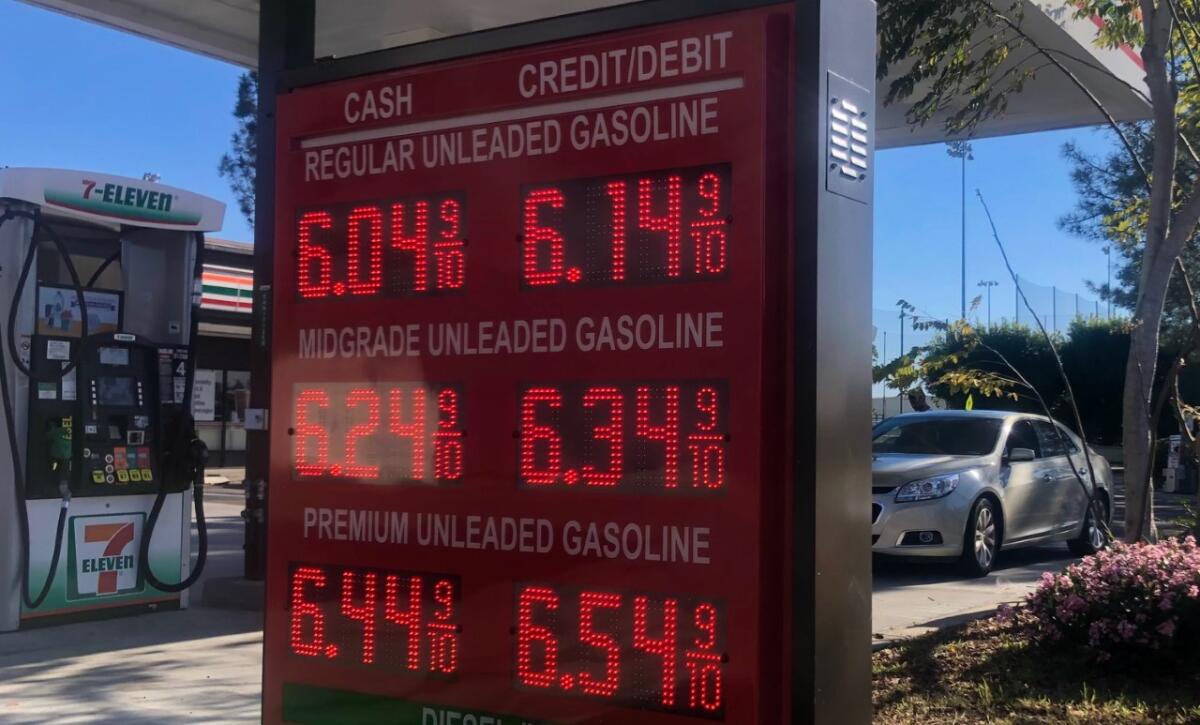Who’s to blame for high gas prices? Democratic lawmakers point the finger at oil companies

WASHINGTON — As consumers fume over skyrocketing prices for gasoline and other commodities, congressional Democrats on Wednesday called executives from big oil companies on the carpet to explain why they appear to be making unseemly fat profits in the face of an international crisis.
The House hearing was in part a response to Republicans’ campaign to blame Democrats for inflation, now running at a 40-year high and rising.
Oil executives Wednesday insisted that market forces set fuel prices, while Republican lawmakers attacked President Biden and what they called his anti-fossil fuel policies for creating supply shortfalls leading to higher prices at the pumps.
But in both parties, the blaming amounts to little more than political rhetoric and jawboning because neither side is prepared to push for the kind of action that Washington has sometimes resorted to in wartime emergencies.
“This is theater,” said Dean Baker, senior economist at the left-leaning Center for Economic and Policy Research. “I wish I could say they’re going to learn something and they’re going to somehow shape anything they might do. But this is theater.”
In times past, presidents of both parties have taken much stronger steps to curb war-induced inflation. During the Vietnam War, President Nixon called for federal price controls to rein in prices. In World War II, President Franklin D. Roosevelt imposed rationing on gasoline and a wide range of other consumer products, including food.
And a Korean War-era law called the Defense Production Act gives a president far-reaching powers to intervene in an emergency.
But over past decades, leaders in both political parties as well as most economists have come to accept the idea that interference in markets is counterproductive and ill-advised. Today, a politician who suggested something like government-mandated price controls would likely be denounced as radical.
Evidence from the past suggests that such steps, if left in place for long periods, do give rise to cheating and other market distortions caused by government bureaucracy and allocation rules.
“There would have been no gas lines except for government,” said Allen Matusow, a historian at Rice University’s Baker Institute for Public Policy, referring to the first major oil shock in 1973, when cars snaked back for miles waiting to fill up.
Wednesday’s hearing attempted to turn a spotlight on the oil industry, already under attack from Democrats for not doing enough on climate change.
Nationally, gasoline prices averaged $4.164 a gallon Wednesday, down from a record $4.331 on March 11, but still up 45% from a year ago. The average in California was a nation-leading $5.823 a gallon.
Biden’s move to release a million barrels of crude oil a day from U.S. strategic stockpiles — a step taken by several of his predecessors to ease consumer pain — should help, although it usually takes about six weeks for a supply of crude to be processed into fuel and delivered to gas stations.
Meanwhile, temporarily suspending gas taxes, as a few states have done, cuts only pennies on the dollar for consumers, who are seeing record increases at the pump and in their heating oil bills.
And spurred by what looks to be a protracted war in Ukraine, prices may stay uncomfortably high for some time if markets are left to their own.
Against that backdrop, the House Committee on Energy and Commerce chairman, Frank Pallone Jr. (D-N.J.), accused the oil industry of putting profits above national interests.
“The problem facing American consumers is not a result of Biden administration policies but rather the actions oil companies have taken to keep supply low, prices high and profits flowing,” Pallone said in a letter inviting top executives at Shell, BP, Exxon Mobil and Chevron, along with two smaller producers, to testify Wednesday.
In their prepared remarks, leaders of the four integrated energy giants, which recorded a combined $70.5 billion in profits in 2021, avoided the matter of their hefty earnings altogether, although some noted that the industry was hammered the year before when the COVID-19 pandemic caused a historic collapse in demand that sent global oil prices plunging.
The same four companies collectively lost more than $28 billion in 2020, led by Exxon Mobil, and the industry was the only one of a dozen major S&P 500 sectors that recorded negative earnings that year.
The chief executives of Exxon Mobil and Chevron, the two largest U.S.-headquartered oil companies, both referred to the oil crisis a half-century ago when OPEC members imposed an embargo against the United States — suggesting that the blame then, as today, lies not with the oil companies but with geopolitical shocks throwing supply and demand into disarray.
Historically, the single biggest determinant in gasoline prices is what’s happening with crude oil, whose price is set in international markets. Crude supplies were already tight before Russia launched its war on Ukraine in late February as economic recovery and oil demand rose faster than expected.
The price of Brent crude, the international oil benchmark, fell to less than $20 a barrel in mid-April 2020, but steadily rose in 2021 and then shot up this year, to a high of $128 a barrel in early March, after the Russian invasion of Ukraine.
Russia is a major producer and exporter of oil and natural gas. In recent days Brent crude has been trading lower, around $105 a barrel. But prices at the pump, on average, have barely dropped.
In part that may be a reflection of when and at what price oil was purchased, and analysts say retail pump prices generally are quick to rise but sticky on the way down.
What’s more, gas prices can vary widely by region, depending on local conditions, competition and other factors. Michael Wirth, chairman and chief executive officer at San Ramon, Calif.-based Chevron, said his company owns and operates only about 300 gas stations in three states, the vast majority in California.
Overall, he said, there are more than 150,000 filling stations across the country, and almost all of them are at least nominally independently owned businesses.
Even so, the big oil companies do influence prices by how much they produce. When supplies are tight, extracting more petroleum from the ground can help ease pressure on prices.
And Democratic lawmakers were particularly critical of the industry for not turning more of their large profits into productive use, preferring instead to return billions of dollars of excess cash to shareholders by raising dividends and through stock buybacks.
Executives of all four of the major oil firms, who appeared remotely before the Energy and Commerce subcommittee on oversight and investigations, flatly denied that they had kept oil production low to inflate prices and their own bottom lines. And they said their companies were stepping up drilling activity, as did the two smaller energy exploration and production firms, Pioneer Natural Resources and Devon Energy. Oklahoma City-based Devon said it planned to increase rig count by 35% this year, although supply chain problems and a shortage of workers were causing delays.
“I understand the desire to find a quick fix for the recent spike in gasoline prices, but neither Pioneer nor any other U.S. producer can increase production overnight by turning on a tap,” said Scott Sheffield, chief executive at Irving, Texas-based Pioneer, the largest oil producer in the Permian shale basin in Texas and New Mexico.
Still, he said Pioneer plans to expand oil production by about 5% a year.
Amy Myers Jaffe, energy expert at the Fletcher School at Tufts University, said shale oil firms were likely to boost production by about 900,000 barrels a day over a 12-month period, adding about 7% to the U.S. supply.
One way to double that increase, she said, would be for the federal government to incentivize shale oil companies by using the Defense Production Act to allocate steel and other materials needed for increased drilling, while agreeing to pay for and take ownership of the extra oil that’s produced.
Biden administration officials appear open to the idea, but Brian Deese, Biden’s director of the National Economic Council, said Wednesday: . “In the short term, there’s no policy barrier associated with ramping production. And that’s clear because a number of companies are ramping production.”
As for the question of who’s to blame for the high gas prices, Jaffe said there’s plenty to go around:
They include Saudi Arabia and OPEC for their reluctance to pump out more petroleum; the oil giants for choosing buybacks and dividends over investment in more production capacity; and U.S. and Western sanctions against Russia for adding to market distortions.
And consumers themselves share some blame, she said, for driving more and increasing demand, thereby bringing up prices.
“The easy way to pay less for gasoline is to use your car less,” Jaffe said. “So collectively, consumers actually have some market power that they have chosen not to exercise.”
Times staff writer Eli Stokols in Washington contributed to this report.
More to Read
Get the L.A. Times Politics newsletter
Deeply reported insights into legislation, politics and policy from Sacramento, Washington and beyond. In your inbox three times per week.
You may occasionally receive promotional content from the Los Angeles Times.











